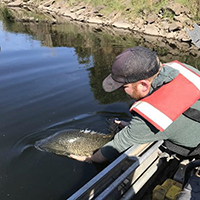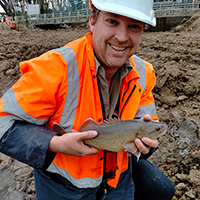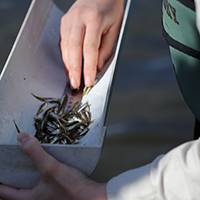Recent monitoring has shown an increase in several species including the recreational fishing favourite, the Murray cod.

Murray cod in the Mitta Mitta
A recent study has revealed natural recruitment of Murray cod in the lower Mitta Mitta for the first time in several decades.
In the mid-1990s Murray cod were believed to be extinct in the Mitta Mitta River in Victoria, with research conducted from 2014 to 2020 showing that cold water pollution in the Mitta Mitta River interfered with several parts of the breeding and recruitment cycle.
With conditions in 2021 reducing the need for releases from Dartmouth Dam and reduced cold water pollution effects, recent electrofishing surveys found an increase in the number of young Murray cod in the lower Mitta Mitta River. Further testing revealed this included both stocked fish and natural recruits.
The occurrence of natural recruits is the first confirmed natural recruitment of Murray cod in the lower Mitta Mitta River since the construction of Dartmouth Dam. The finding shows that Murray cod can recruit in the Mitta Mitta River under warmer water conditions and comes after more than a decade of research and changes to release strategies from Dartmouth Dam. This information will be used to further develop improved river operations strategies aimed at enhancing numbers of Murray cod in the Mitta Mitta River.
The fish monitoring was funded by the MDBA in collaboration with Goulburn–Murray Water, the Arthur Rylah Institute, North East Catchment Management Authority, and the Mitta Mitta Community and Fishing Club.

Murray–Darling rainbowfish and trout cod in Gunbower Creek
Since 2013, threatened and critically endangered native fish have been benefiting from water for the environment in Gunbower Creek in Victoria.
How well native fish are responding to these flows was demonstrated again when the North Central Catchment Management Authority found 100 threatened Murray–Darling rainbowfish and 28 critically endangered trout cod during construction works. The fish were discovered while building fishways at the Cohuna and Koondrook weirs. Fifty Murray cod were also found. Delivery of water for the environment has supported native fish breeding cycles and helped both naturally bred and stocked fish to survive and grow in Gunbower Creek. Fish monitoring to check in on the health of the local native fish population in Gunbower Creek is carried out each year through The Living Murray program.

Murray hardyhead at Katarapko
Record numbers of critically endangered Murray hardyhead were rediscovered in the River Murray at Lock 4 within the Katarapko Floodplain in South Australia.
The weir pool at Lock 4 was raised 30 cm above normal levels using water for the environment to inundate parts of the Katarapko Floodplain.
Throughout the weir pool raising, South Australia Department for Environment and Water (DEW) completed monitoring of the Murray hardhead population in the Gurra Gurra Wetland Complex to see what influence the water for the environment event was having. During a single sampling event the team caught almost 25,000 Murray hardyhead and across the whole survey period more than 75,000 individuals were captured. The monitoring will investigate the links between Murray hardyhead breeding and weir pool raising to inform future management. This work forms part of the $155 million South Australian Riverland Floodplains Integrated Infrastructure Program to improve the health and resilience of riverland floodplains.